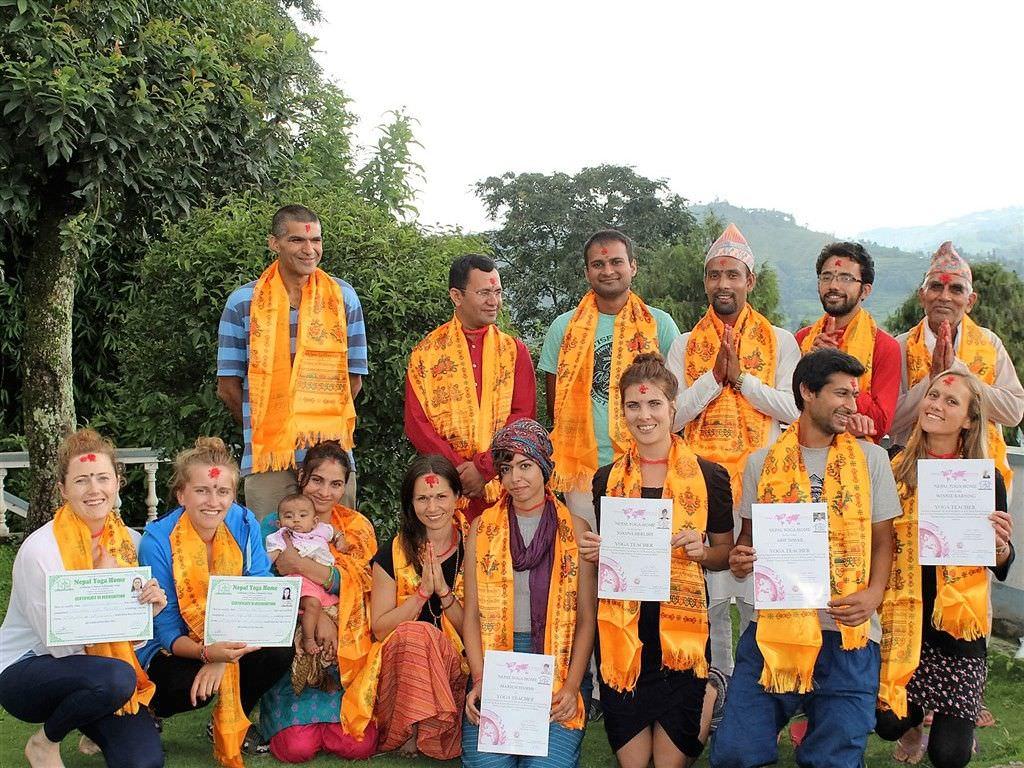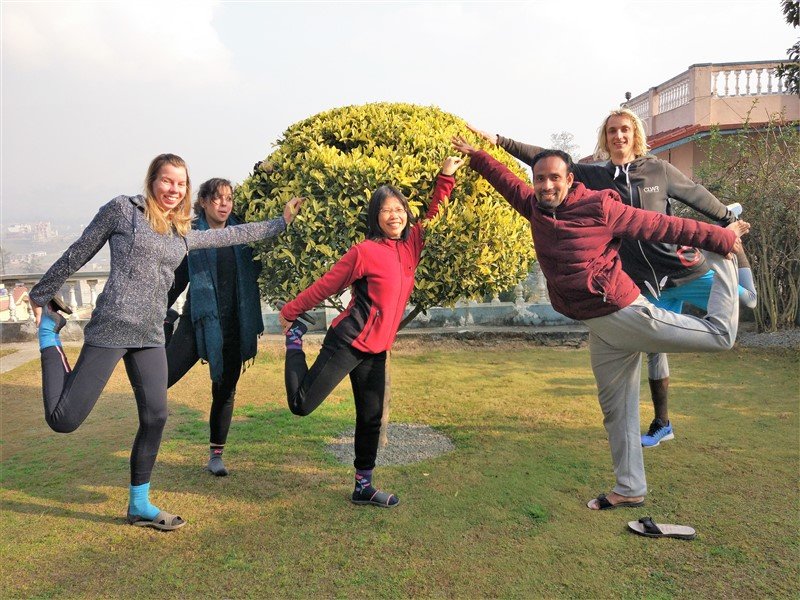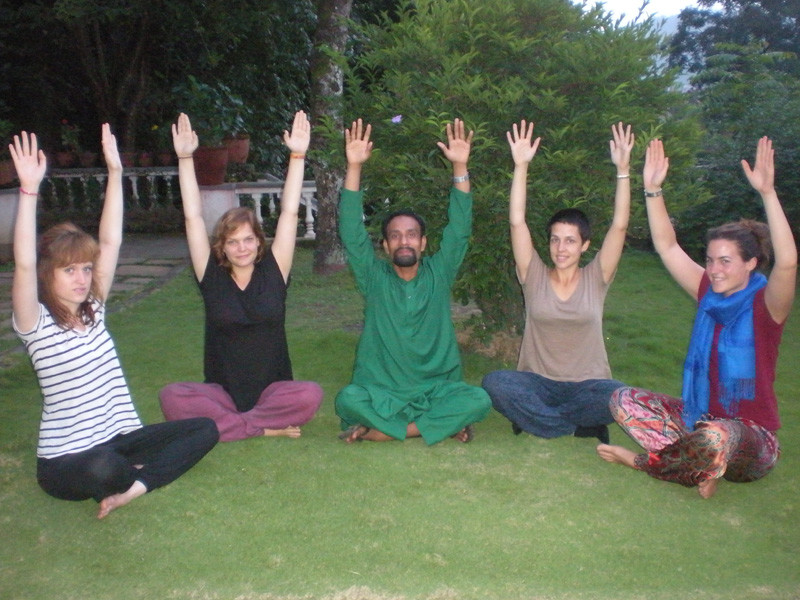
by Tirtha Acharya | Apr 7, 2018 | Yoga, Uncategorized, Yoga Therapy
The word “yoga” is derived from the Sanskrit word yuj means “union”. Yoga is a union of mind, body and soul. It is the peaceful and calmness situation of one’s state mental and physical state. Yogi is a male who practices yoga while a female is yogini. Today yoga is a form of physical postures that purifies the body and provides physical strength and stamina. These physical strength and stamina is required so that yo can engage in meditations for long period of time. You should practice under a yogi. Nepal Yoga Home, a pioneer yoga retreat in Kathmandu, offers best yoga class in Kathmandu. Read on to find out the benefits of yoga as well as why we have the best yoga class in Kathmandu.
Due to outstanding performance and spiritual life-changing environment to offer, Nepal Yoga Home has the best yoga class in Kathmandu. Yoga aspirants from all around the world flock to yoga class in Kathmandu. It offers various courses ranging from beginners level yoga class to the advanced level yoga class. This yoga studio in Nepal is run by the yogis. The yogis of Nepal yoga home are dedicated to spread the benefits of yoga all round the world. We will teach you what is the main consideration for a human being. It is necessary to have a harmonious life. It provides the proper art of living methods and techniques. In this yoga class in Kathmandu, you can rejuvenate your physical body as well as calm your mental states. The best part is that this yoga class in Kathmandu is just five kilometers from the main city center.

4 Benefits of Practicing Yoga
Yoga practice benefits the body
Through best yoga class in Kathmandu, you can make your body stronger, increase flexibility, perfect your posture and protect your spine. The practice of yoga increases your blood flow, ups your heart rate, drops your blood pressure and rejuvenates your body, mind and soul.
Yoga practice brings balance
Yoga brings balance in your body through thoughts, words and actions. It cultivates a deep experience of outer and inner balance so that the rhythm of your body matches and you feel peaceful. There is constant conflict between our inner soul and outer body. The yoga class in Kathmandu exactly fulfills this void and you will be able to lead your life peacefully.
Yoga practice invites mindfulness
In the yoga class in Kathmandu, we will teach you in a way that you will be able to know your self. Yoga is an important tool to know your-self. It teaches you to stay in the present moment. Yoga class in Kathmandu teaches you to accept yourself in the way you are. In addition to that, it helps you to focus and be mindful of the situation around you. Yoga relaxes your system and maintains your nervous system.
Yoga practice is freedom
First of all, you need to know that, Yoga is the way to to find freedom. You need to find that freedom from within. Yoga class in Kathmandu helps you to be brave so that you will be able to look within. It can help you change your life. In yoga, what you do to yourself matters, after a trial at yoga class in Kathmandu you will start feeling better. Also your self esteem is rejuvenated and you will experience your life in a whole new level.

Experience Yoga at Best Yoga Class in Kathmandu
Nepal Yoga Home has been offering yoga class in Kathmandu since very long period of time. Apart from yoga training, Nepal Yoga Home also provides yoga teacher training from beginner level to advanced level. Other facilities for yoga and meditation in Nepal are also available in Nepal Yoga Home. In this article we will explore the three main reasons why yoga class in Kathmandu is best at Nepal Yoga Home.
Perfect Location and Yogic Food
Nepal Yoga home is situated in the enclosure of the Nagarjuna jungle. The Nagarjuna jungle is itself named after the enlightened monk. The closeness to the nature at yoga class in Kathmandu will hypnotize you to remain cool, calm and balanced. The local and organic foods is served during your stay. Nepal yoga home grows some of the vegetables themselves beside the hall. At yoga class in Kathmandu, you can experience the vegetarian and sattvic meal during your stay. Furthermore, the food is in highly sanitized condition and delicious to eat.
Affordable and Economic Fee with Welcoming Hospitality
Nepal Yoga Home is on a mission. The mission is to spread the benefits of yoga to all the people of the world. For this reason, the fee of yoga class in Kathmandu is affordable and economical. The course of yoga class in Kathmandu is not only low cost but also you can get well managed rooms. We have managed everything for you so that you can have a yogic lifestyle. Furthermore, the hospitality of the Nepali people is unquestionable. As a visitor and learner in yoga class in Kathmandu, you will get total respect. You can ask any sort of help that you require. The local language is Nepali but also English is widely spoken. You can ask for directions easily and people will always smile. Don’t forget to say, “Namaste”
Experienced and Professional Yogi as Teacher
Yoga class in Kathmandu has the experienced and affectionate teacher. They will also do their best to share idea and skill. The teaching style of yogis is also inspirational. In addition to that, you can get some really helpful insights so that your learning is useful. The manner of teaching is also eastern style at Nepal Yoga Home. In yoga class in Kathmandu, you can have the different flavors of learning experience. Each yogi will have a different style and you will get to learn from all of these.
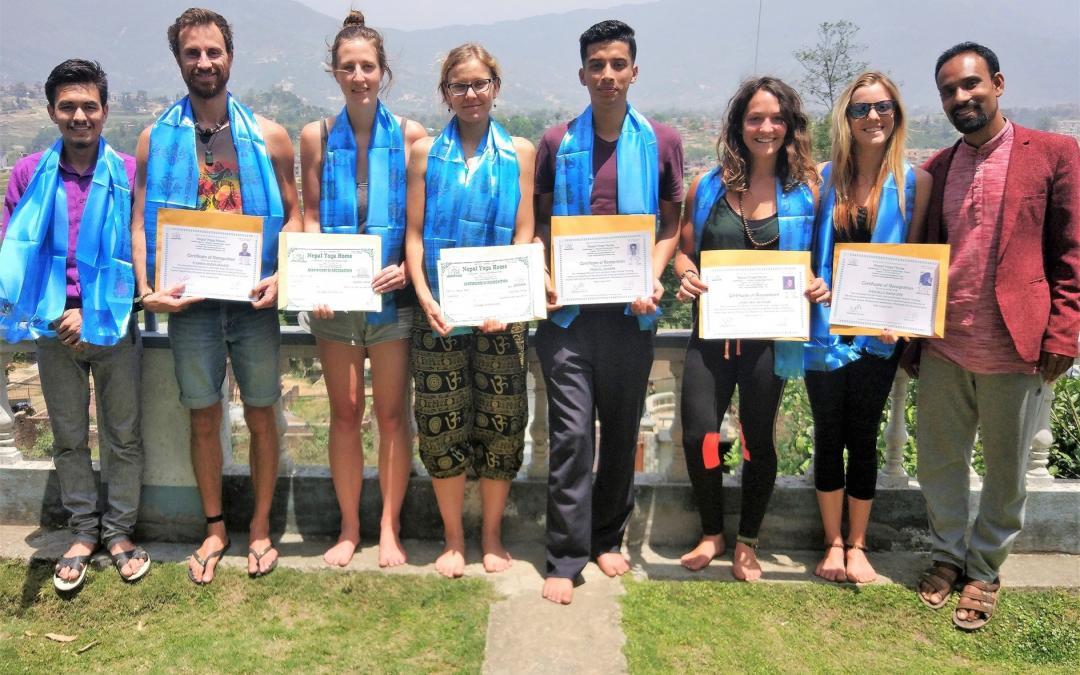
by Tirtha Acharya | Apr 3, 2018 | Yoga, yoga training and yoga courses
Yoga training in Nepal brings students from all ages together to learn from each other’s body types, their flexibility, their strengths, and their tolerance levels. Yoga teacher training is thought of as a journey into self mainly inward journey. It will obviously impact your yoga skills that are practical like alignment and body awareness. In addition to that, it offers benefits that are beyond physical and that is amazing. You are going to need yoga certification in Nepal and Nepal Yoga Home is here to help with a wide range of courses from beginner to advanced level. Yoga certification in Nepal is a rewarding experience that you ever experience in your life.
Whether you are in need of additional yoga training hours out of curiosity, or want to become self-employed, or spread the joy and peace to make this world a better place through yoga, then yoga certification in Nepal is best for you. Nepal is one of the ancient playgrounds for yoga. If you become a certified yoga teacher it offers the freedom of self-employment. As well as you can teach both locally and internationally as you will be certified by Yoga Alliance. You also remain connected to a large family of yoga teachers and yogis from all around the world. They will support you through your journey for all your life. Yoga certification in Nepal has to offer you all those benefits and a lot more.
Get Yoga Certification from Nepal Yoga Home
You will feel connected despite the beliefs you share. Moreover, your understanding increases through the spiritual practice of yoga teacher training. This awareness that yoga provides is to live a more conscious lifestyle and prioritize on what matters most. After the completion of the yoga certification in Nepal, you will be a yoga teacher. Use your newly acquired power to develop your unique style of teaching as well as methods. These will be authentic and new. You can make an impact in the life of your students. Offer your students with peace of mind. Being a yoga teacher, you can spread the joys and peace not only to students who come to you to learn but also to people who are not able to come to you.

Nepal Yoga Home is a globally recognized organization that is promoting and teaching yoga and meditation retreat in Nepal. It is one of the pioneer yoga alliance certified yoga training institute in Nepal. Apart from yoga training in Nepal and yoga teacher training in Nepal, Nepal yoga home offers certified yoga teacher training course 200 hours, 500 hours, as well as yoga retreats, yoga holiday and yoga detox, Ayurveda courses and reflexology courses. It also offers yoga certification in Nepal. All the courses include a residential experience, living with a yogi’s family and being immersed in the beautiful, natural and panoramic environment just some few kilometers of Kathmandu.
We Welcome All Yoga Lovers To Pursue An Advanced Level of Yoga
Advanced Yoga Teacher Training in Nepal at Nepal Yoga Home provides the depth and discipline of yoga. This depth and discipline lift you into physical well being, mental relaxation, and spiritual peace. We have designed yoga certification in Nepal according to the international standards. Our yoga courses are certified by the Yoga Alliance. After the completion students will receive a yoga alliance certification. The yoga teacher training is intense and challenging as well as a life-changing experience. You will get a comprehensive understanding of the practice of yoga. It includes asanas, meditation, pranayama, yoga detox, yoga philosophy, mantra chanting, chakras, anatomy, mudras, bandha, etc.
For yoga certification in Nepal, Nepal yoga home has a professional team of experienced and qualified yogis as teachers with their own style and methods. They will teach you the concept of different yoga styles for yoga training in Nepal and yoga certification in Nepal. You can choose from a range of courses like 300 hours of Yoga teacher training which will lead you to 500 hours of yoga teacher training. All of our training leads to yoga certification in Nepal. After the completion of this training, you become a certified yoga instructor. Visit the following links for more information:
300 Hours Advanced Yoga Teacher Training
500 Hours Advanced Yoga Teacher Training
Aum Shanti Shanti
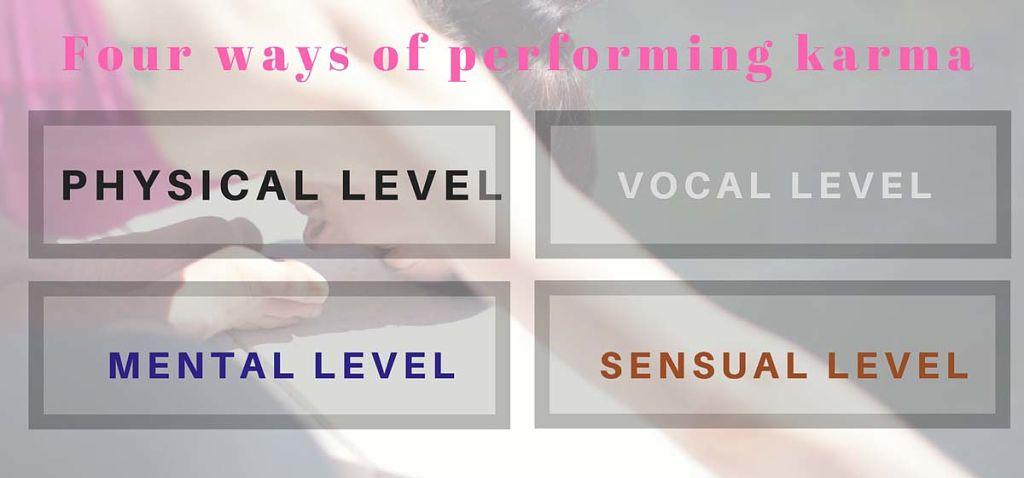
by Tirtha Acharya | Mar 24, 2018 | Yoga
The law of Karma says that each action that we are performing continuously does not get disappeared without a mark or an effect. It creates an appropriate result for the performer. He has to face the consequences of is Karma at any cost. It is impossible to ignore the result. The result of the Karma appears quicker or delay as per the nature and intensity of the Karma. For the fruits of Karma, there will be the interplay of a variety of different factors such as intention, desire, will, feelings, efforts and its repentance, self- change, hidden power of nature etc. Aurobindo defines Karmic Law as –“According to the energy put forth; shall be its return, subject to the complicated working of many world forces.” Forces, here, means mental and sensual activities like intention, desire, will, want etc.
Karma is the Sanskrit word which literally means an ‘action’. The root of the word is ‘Kri’ which means “to do” or “to perform”. Thus, to do all action is Karma. The actions or Karma is performed in four ways:
Physical Level
They are outer actions done by the physical body. Providing help to the needy, working in an office, robbery, killing etc are the physical karma. Besides, activities of the body where conscious mind is not involved such as sleeping, moving body, sneezing, yawning, blinking of eyes, breathing etc are also a part of physical Karma.
Vocal Level
The words that you speak are a part of the vocal action. Speaking honest words or dishonest words, kind words or unkind words, backbiting, slander, words that propagate lies and hate etc all are the karma at vocal level.
Mental Level
The activities of different types of thoughts and feelings are called the karma at Mental Level. When the mind is filled with positive thoughts and good feelings such as- love, empathy, kindness, etc. then it is a positive Karma. Negative thoughts, bad feelings like- fallacy, deceit, untruth, hatred, anger, jealousy etc are the part of negative Karma.
Sensual Level
Actions of 5 sense organs (eye, ear, skin, tongue, nose) are said to be actions at sensual level. We can use the eyes differently to watch both positive and negative. Reading a book and collecting knowledge is an action of eyes. Watching pornography is another action of eyes. Again question may arise- is watching pornography is a sin or a bad karma, and reading a book is good karma! Later on, we will come to know what is right and what is wrong. Anyway, the activities of eyes to see different things are karma. Hearing different things, sense of smell, touch, and taste etc all constitute Karma.
Karma encompasses each and every type of action. There is no any choosing and rejecting any types of action. Each and every action that we perform consciously or unconsciously is the Karma. It may involve body, speech, mind, and sense or some combination among these four. Thus Bhagawat Geeta states,-“None can remain to do nothing even for a moment, everyone is driven to action by the modes of nature born qualities.” So, for every moment living beings keep performing actions knowingly or unknowingly.
For each action, there is a reaction. Thus, the law of Karma is also referred as “the law of action and reaction” or “the law of cause and effect”. When the reaction is good, people call it reward, and the bad reaction is said as a punishment. Whatever the seed of Karma is sowed, the fruits will be ripened as per the seed. Many people are unaware of Karmic Law. Had all people know about it there will be no crime and no anti-social activities. The Law of Karma has perfect eyes. Law of Action can be compared Newton’s Law of Motion that every action has an equal and opposite reaction. Whatever we think, speak, intent or act; our life rolls accordingly. There is one event in Buddha’s life related to law of karma:
Buddha was preaching his disciple. He told that for every suffering, meditation is the solution. One of the audience said,-“There is your disciple who is by birth blind. What can be more troublesome misery than to be blind? How is his misery cured?” Buddha and his disciple including the blind disciple listened to it and got curious about the audience’s question. Buddha closed his eyes for a while. Buddha had the power to see past and future. He tried to see the past of the blind disciple’s life. In one of the past lives, Buddha found an important Karmic issue. In that very life, the blind disciple was an ayurvedic doctor. One day a lady with eyes problem came to him and said,-“Dear doctor, I finished my entire property for treatment of my eyes but got unsucceeded. Now, I have no money. If you can cure my eyes, I including two children will be your servant throughout the life.” The doctor started her treatment. After the treatment of a week, her eyes got improved. The eyes were on the way to complete cure. But, the lady got feared for her promise to the doctor. She thought that to be servant including her two children throughout the life will be difficult. So, she tried to deceive the doctor. She told the doctor that the condition of her eyes was degrading. The doctor became angry because he knew the real condition of her eyes. In fact, the intention of the doctor was not to keep them servant throughout their life. The doctor would treat the lady for free or on credit whatever the lady wants. However, due to lying of the lady, an evil thought aroused in doctor’s mind. The treatment was continuing. The following day of the lady’s deceives, the doctor kept poisonous substance into the lady’s eyes in the place of medicine. After that, the lady became completely blind. Buddha revealed this secret to the audience including all of his disciples. He also taught that all people must have to face the fruit of their Karma in the very life or in coming life. According to law of karma, One can never escape from his Karma. However, now the blind disciple is walking on the right path with the right intention. This will slowly minimize the effects of the bad Karma.
There is a perfect law of Karma. It looks whether a mistake is done knowingly or unknowingly; intentionally or unintentionally. The reaction of the action will appear accordingly. For example, a cricketer hit a person with a cricket ball while balling. Now, his intention was not to hit. Had he hit intentionally the reaction would be different. Killing a person by a murderer by a knife and death of a patient with a knife of a doctor’s hand while doing operation will create different reactions. The murderer kills intentionally but the doctor has the different case. Thus, fruit is also different. If a person does any mistake, but, later on, he realizes and moves in the right path; then the effect of bad karma will be reduced.

by Tirtha Acharya | Mar 23, 2018 | Yoga
Precaution for doing Asanas and Pranayama for best practice and positive change
Yoga asanas and pranayama are considered to be effective to improve physical, mental and spiritual well-being. The regular practice of yoga helps in making body flexible, cultivating character, proper breathing, sound relation and proper sex. It awakens the real potentialities of a human. However, practicing the asana in a wrong way (without caring the precaution for doing asanas and pranayama) can have negative effects rather than building positive changes in the body and mind. Thus, it is advised to practice asana only under the proper guidance of an experienced teacher or you need to have correct knowledge. Some of the precaution for doing asanas and pranayama are listed below:
Time to do Yoga: considered as an important precaution for doing asanas
- Practicing asana and pranayama early in the morning before breakfast is considered to be the best. The second better time is early evening, around sunset.
- Asana can also be practiced at day or night time when the body feels tired, tensed, or stiffed.
- Asana and pranayama can also be practiced in other time as well but there should be the gap of about 4 hours after a heavy meal and 2 hours after a light meal. It is also suggested that there should gap of about half an hour.
- It is not good to do too many over stimulating asanas before bedtime.
- Sitting, walking and sleeping in a correct posture is also an asana. So, if you become conscious there is yoga every moment.
- Pranayama is best to practice just after the asana, and meditation is highly effective if done after pranayama. However, it is no compulsion to follow the order. Meditation may be done at any time whenever you are free.
The place to do Yoga
Among several precautions for doing asanas and pranayama place of doing the yoga play vital role in the effectiveness.
- Yoga can give the best result if practiced in airy, quiet and peace which suits for better concentration and awareness.
- Better not to practice asana or pranayama in direct sunlight for a long duration. If it is before 10 am and body is getting comfort then it is ok. Indoor or outdoor does not matter but avoid cold wind, unfavorable temperature, insects etc.
- The ground should be well labeled.
Consciousness
- Practicing yoga without awareness is useless. Keep awareness throughout the yoga practice what you are doing. If you are practicing asana, concentrate on your own body. Try to feel the sensation and observe the breath. Be conscious of self, not outside. Be conscious so that you can perform asana with correct alignment.
- Practice comfortably and mindfully.
- When you are doing pranayama, be watchful in your posture so that your torso and neck will be always straight.
- Never force or strain hard. Don’t twist or bend the body in a jerky manner. If it is uncomfortable then don’t do.
- Take short relax between each asana or pranayama.
- Whenever you get free time practice observation on respiration for better practice of consciousness.
Respiration
- The nose is for breathing and the mouth is for eating. So, always breathe through the nose, unless instructed otherwise.
- In case problem to breathe through the nose, practice Jala neti or sutra neti. You can also take help from the expert.
Restriction
In fact, there is no restriction in yoga for any age. However, techniques, asanas, and pranayama may vary according to age and gender.
- All practitioners should not do khumbhaka (holding the breath).
- Most of the people are forbidden to do Sirshasana.
- There are different asana and pranayama that should be avoided by different patients.
- Avoid practicing yoga under the influence drugs or alcohol.
- Sometimes, people with heart diseases, high or low blood pressure or other serious organic problem have to avoid the asanas.
- Those who have disabilities or with the chronic medical condition should consult both medical doctor and yoga teacher.
- Do not practice pranayama unless you master sitting posture.
- Do not make a loud sound during pranayama. However, some pranayamas such as Bhastrika has a different rule.
- In case of tiredness, take rest in savasana and be fresh. After that, you can practice pranayama.
- Pranayama should be done peacefully and calmly, not in a hurry.
- If lungs are congested, don’t practice pranayama.
- Suryabhedi pranayama can be done only in winter and chandrabhedi in summer.
- People with high blood pressure, heart diseases or a hernia need to prohibit Kapalabhati and Bhastrika
- Shitakari pranayama should be avoided by people with low blood pressure. It also should be avoided in winter as well.
Clothes
- Clothes should not be tight and uneasy. It should be enough loose or elastic to perform asanas.
- A practitioner should use such dress which will not disturb for the practice of yoga.
Religion
- Yoga is universal and for all because health and wellness is for all. So, no religion needs to avoid yoga.
Food
- There is no hard and fast rule for food. However, taking unhealthy food is not ideal.
- No matter, whether you are vegetarian, non-vegetarian or vegan; you can practice yoga.







